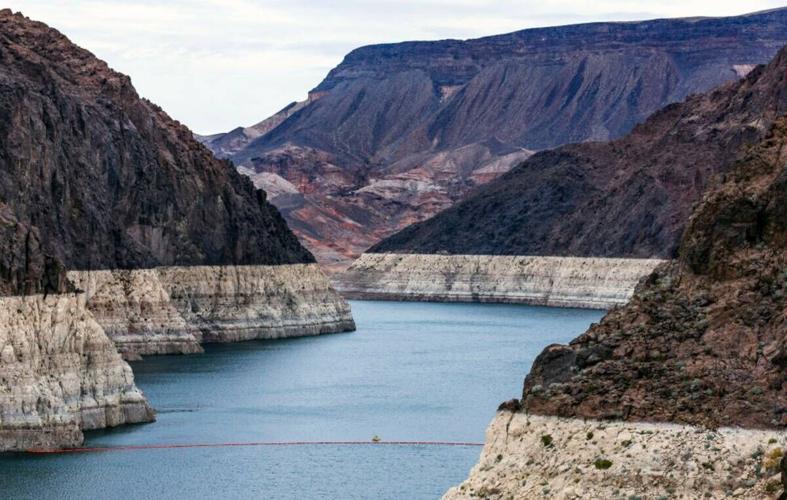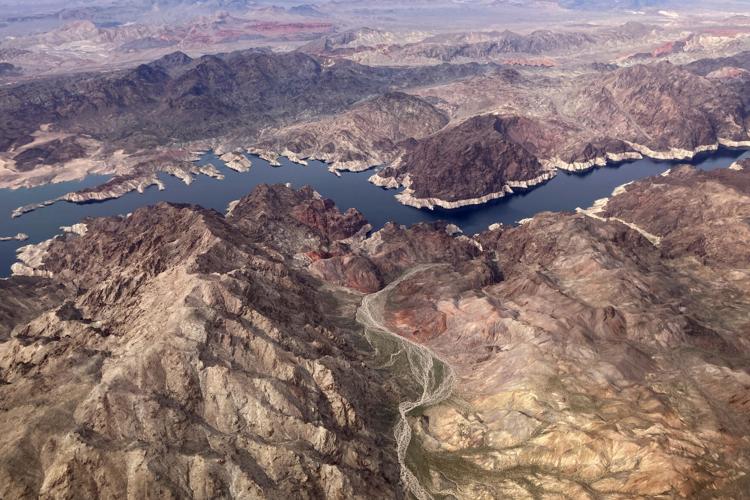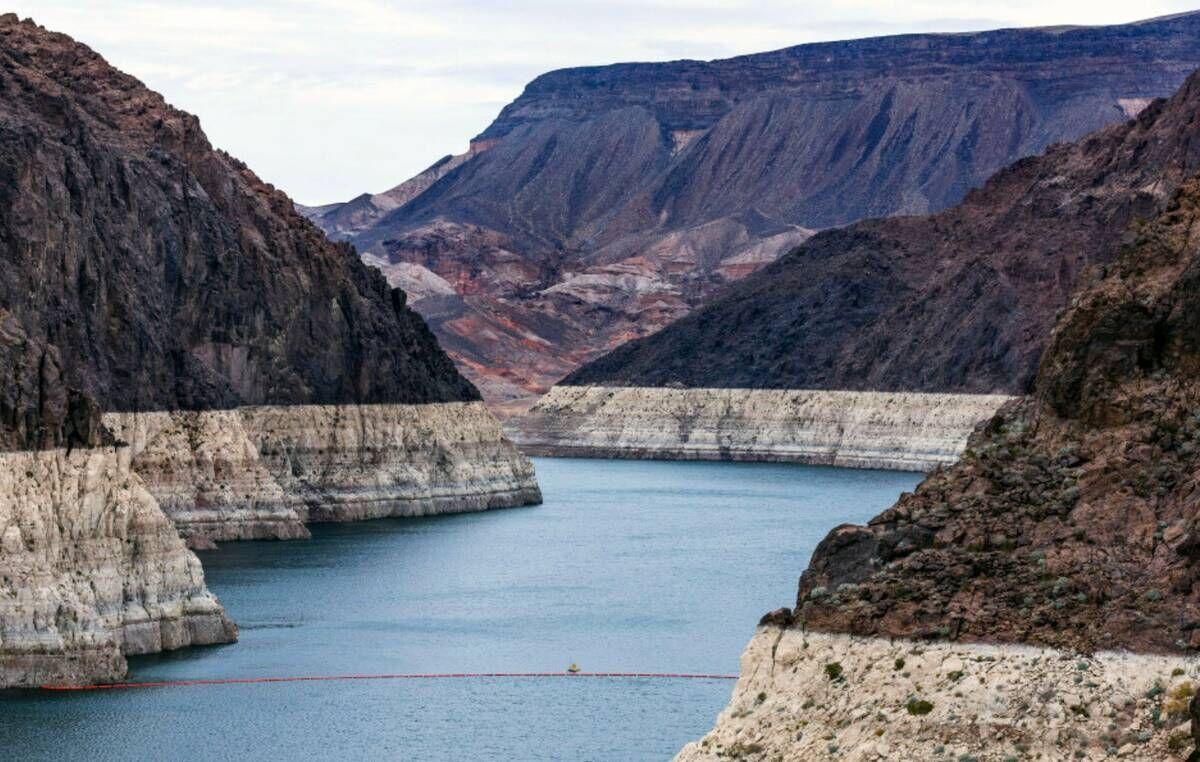A federal plan to spend $250 million to conserve enough Colorado River water to raise Lake Mead 10 feet this year could delay the onset of mandatory, uncompensated cuts to Tucson’s Central Arizona Project supplies, forecasts show.
Raising Lake Mead 10 feet could keep the reservoir from falling far enough to worsen the river’s shortage to the point that would, for the first time, require cuts in CAP deliveries to Tucson.
Overall, the water savings resulting from the $250 million in spending will amount to “putting a little bit of a Band-Aid on a wound,” said U.S. Sen. Mark Kelly, an Arizona Democrat who successfully pushed for this funding as part of last year’s passage of a federal climate-oriented law.
The money will be spent to compensate some entities for using less water from the Colorado River. The resulting cut in water use would range from 16% to 32% of the amount federal officials want the river basin states to reduce from their use, to maintain the Colorado’s declining reservoirs above critically low water levels.
The U.S. Bureau of Reclamation’s recent announcement that it will spend the money to compensate river water users for reducing their take could have another benefit, as well. It should greatly improve the chances of the seven river basin states reaching an agreement without litigation for a deal over much larger cuts in their use, Arizona’s top water official said.
Voluntary conservation
The bureau said the $250 million will pay for voluntary conservation by various river water users of 650,000 acre-feet of water this year. That’s equivalent to about two-thirds of the total amount of Colorado River water delivered to Tucson, Phoenix and other users via the $4 billion CAP canal system.
More savings are possible in 2024 and 2025, depending on what kind of agreements Reclamation reaches with cities, farms and tribes that use the river’s water. As the program is structured, users can take payments for saving water for one to three years.
The bureau announced the availability of the money at a March 10 drought roundtable session in Phoenix organized by Kelly.
The federal agency didn’t specify who will get the money and how much each individual user who receives it will cut their take from the river. It said it’s still finalizing contracts with water users. Details should be released by the end of this month, said Marisol Samayoa, Kelly’s deputy communications director.
The $250 million payout comes as Arizona and the other six river basin states are locked in difficult negotiations over how to meet a Reclamation demand that they save 2 million to 4 million acre-feet a year of river water. Those cuts would be aimed at propping up Lakes Mead and Powell, and closing a major gap between the Colorado’s supply and demand.
Late last week, Mead, the nation’s largest reservoir, stood at about 1,045 feet. That’s low enough for shortages to have been declared in water deliveries to the CAP system serving drinking water to Phoenix and Tucson. But it’s not low enough to declare water will be taken from Tucson under previously agreed-upon plans. CAP is currently Tucson’s main if not exclusive source of drinking water.
Most of the cuts have gone to Pinal County farmers; the use of CAP water to replenish the aquifer for future use; and some Phoenix-area cites.
Tucson impact
Mandatory cuts in CAP deliveries to Tucson won’t be required under the current federal drought contingency plan until Mead falls below 1,025 feet at the end of a calendar year.
The most likely forecast for Mead from Reclamation is for it to fall to 1,034 feet at the end of 2023 and to 1,018 feet at the end of 2024. Under the bureau’s forecast for the lowest likely river flows, Mead would fall to almost 1,023 feet at the end of this year and to 1,005 feet at the end of 2024.
So if the lake is boosted 10 feet, that could keep it from falling below 1,025 longer, under either scenario.
Tucson might still take a cut in CAP deliveries this year. It’s one of many entities negotiating with the bureau to grab a slice of that $250 million in exchange for reducing its river water use. It hasn’t reached agreement with the bureau yet on how much money it would get and how much water it would leave in the lake, but “we have indicated to the (bureau) that we would be interested in a multi-year agreement,” Tucson Water said last week in a statement.
But that would be a voluntary cut in return for compensation, as opposed to the mandatory cuts called for under the existing federal drought contingency plan. And Tucson might also have to swallow a mandatory cut in the near future when and if the seven-state river basin negotiations come up with a compromise solution, or when and if the bureau imposes its own cuts if the states don’t reach agreement.
‘Buys us more time’
Overall, the bureau’s announcement of release of the $250 million “shouldn’t indicate to anybody . . . that this is what we need to do to fix this problem,” Kelly said.

In this aerial photo, a bathtub ring of light minerals show the high water mark on the shore of Lake Mead along the border of Nevada and Arizona, March 6 near Boulder City, Nev.
“We think of it as putting a little bit of a Band-Aid on a wound. It’s a positive outcome and positive result of” the Inflation Reduction Act, the 2022-passed law that contains $4 billion for Western drought relief including this $250 million, Kelly said.
Kelly and fellow Arizona Sen. Kyrsten Sinema, then a Democrat but now an Independent, pushed hard for appropriation of the $4 billion under the act. “But there is so much more that we have to do” to make a meaningful impact on the system, Kelly said.
“It buys us more time, as we work together on long-term solutions — some from the Inflation Reduction Act, others from the long-term, Bipartisan Infrastructure Law” that Congress passed in 2021, Kelly said.
As for the seven-state river use negotiations, the states are deeply split in their stances so far. Arizona and all other basin states except California are pushing for a plan that would apportion much of the necessary cuts according to which users cause the most evaporation in the river. That plan would take the biggest cut from California, the heaviest river water user.
California is pushing a plan that would protect more of its river water supply because it has a higher legal priority right to the water. California’s plan would impose far larger cuts on Arizona and to a lesser extent, Nevada. Many outside water experts have warned there’s a good chance this dispute will have to be settled through a lawsuit.
Helps avoid litigation
But Arizona Department of Water Resources Director Tom Buschatzke said at the March 10 drought roundtable that “absolutely” the $250 million will help avoid litigation over who will take the biggest share of future cuts in river water use.
The smaller the amount of uncompensated water use cuts that can’t be mitigated by additional, replacement supplies, “the less likely there will be litigation,” Buschatzke said.
“We often talk about numbers, but what we’re really talking about here is (people’s) lives, their livelihoods, their lifestyles. For the tribal communities, it’s their homelands,” Buschatzke said of those who could lose their river water.
“These are visceral issues for folks. We have to find a way for a series of compensated conservation efficiencies here to minimize those painful cuts. This money will help them do that,” Buschatzke said.
The states have made a “lot of progress” since the six-state and California proposals surfaced at the end of January, he said.
“Moving forward, I’m very optimistic that these funds, both in the near term and the long term, can get us to a positive outcome regarding collaboration,” the director said.
Using that money to “leverage” other water funds held by states can also help avoid litigation, he said. That includes $200 million the Arizona Legislature authorized spending last year towards municipal-based water conservation, and $30 million the Legislature also approved last year for research to improve irrigation efficiency.
“This is an historic moment for our state and our region,” Buschatzke said. “Litigation will be very uncertain, take lots of time. . . If it occurs, somebody’s got to still do something to protect the system, and it will be very difficult I believe to have dialogue between the states if litigation is ongoing. We will retreat to our corners. We will have to protect our litigation positions.”
Helps reduce demands in short term
A top California negotiator essentially agreed with Buschatzke.
This season’s expectations of improved spring-summer runoff into the river, “along with significant available federal funding, will make a true seven-state consensus approach more achievable,” said J.B. Hamby, chairman of the Colorado River Board of California, which represents the state in Colorado River negotiations.
The $4 billion in funding in the Inflation Reduction Act for drought response “will go a long way to help basin states reduce demands in the short term and protect the system,” said Hamby, also a board member for Southern California’s Imperial Irrigation District, which controls the largest share of river water rights.
California’s Colorado River users “expect to utilize this available funding for near-term and long-term programs and projects that will reduce use from the river,” Hamby said.
The Southern Nevada Water Authority is reserving comment on the $250 million federal expense because “we don’t have any real clear understanding at this point as far as where those dollars are going,” water authority spokesman Bronson Mack said.
Eric Kuhn, an author and water researcher in Colorado, said, “in the short run, yes,” the money will help with negotiations. In the long run, as the states gear up for more complex negotiations over operating guidelines for the reservoirs that expire in 2026, there’s “still a lot of tough issues to work out — including reservoir evaporation,” Kuhn said.
Longer-term effort
For longer-term help for the river, Kelly said he’s pushing the Biden administration to release funds obtained via the 2021 infrastructure law to spend on various Lower Basin water projects.
The projects include upgrades to a canal, wellfields and a reservoir in the Lower Basin; projects to improve farms’ water use; and environmental restoration work at Southern California’s Salton Sea. There, lowering water levels are drying up the seabed, slashing bird and fish populations and allowing more toxic dust to be released into the air.
Kelly, Sinema and both California senators, Democrats Dianne Feinstein and Alex Padilla, also recently wrote the bureau to urge it to invest still more money from the 2022 Inflation Reduction Act into technologies to help farmers move from thirsty flood irrigation practices to more water- and energy-efficient drip irrigation.
“Doing so will save significant amounts of Colorado River water while avoiding the harmful impacts of fallowing,” the senators wrote. “If farmers continue to maintain and operate these systems, water savings generated by the use of micro-irrigation, automation, or other technology would be replicated year after year, while avoiding the social, economic and food security repercussions of fallowing productive farmland.”
Longtime Arizona Daily Star reporter Tony Davis talks about the Colorado River system being "on the edge of collapse" and what it could mean for Arizona.







